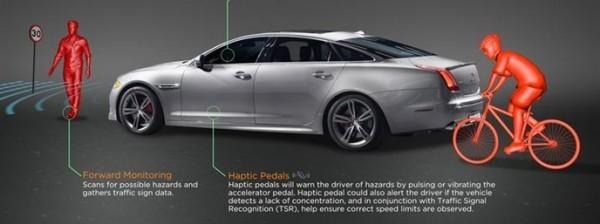Jaguar Uses Brain Wave Monitoring To Keep Drivers Alert
Auto manufacturers are getting smarter all the time. Jaguar Land Rover has just created a car that can read your mind. The car won't psychically take you to your destination, but it will hold your attention. The prototype feature, dubbed Mind Sense, measures brainwaves to monitor the driver's concentration. It was developed as a safety technology research project, which has the overall goal of decreasing accidents on the road. Drivers whose concentration fades due to stress or distraction pose a real threat to others on the road. It doesn't matter if a driver's eyes are on the road, it just takes a daydream to keep him out of touch with surroundings–only to be yanked back by a car horn or an accident. Jaguar's Mind Sense project found a way to tell whether the driver is paying attention or not based on his brain wave patterns.
Our brains are always generating an array of specific brainwaves. As mental status changes from sleepy or distracted to focused, different dominant frequencies emerge. Jaguar developed an onboard computer that can identify which state you're in.
According to project director, Dr. Wolfgang Epple, "If brain activity indicates a daydream or poor concentration, then the steering wheel or pedals could vibrate to raise the driver's awareness and re-engage them with driving." If that doesn't work, the car could escalate its response to with a warning sound, then an icon. It would continue until the driver's brain waves indicate he is sufficiently alert.
Unfortunately, even the most compact methods of monitoring brainwaves are achieved by a bulky sensors and a headband, which isn't ideal for driving. Jaguar is looking into an alternative method used by NASA to measure concentration that involves detecting brainwaves through the hands by using sensors on the steering wheel. Apparently brain waves can be detected through fingertips, but the signals are much weaker and require software algorithms isolate and amplify the brainwaves.
Alongside Mind Sense, Jaguar is developing a driver wellness monitoring system that would use sensors in the car seat to monitor the driver's breathing and heart beat. These developments tie into self-driving research as Dr. Epple points out, "As we develop more autonomous driving technologies, there will be instances when the autonomous car needs to hand control back to the driver."
Jaguar is also developing a predictive infotainment system so drivers spend less time toying with their dashboard and more time focus on the road. Using cameras that track the driver's hand motions, selections can be chosen mid-air and given an ultrasonic sensation of touch known as "haptic feedback."
Haptic feedback can also be incorporated into the pedals. The accelerator could vibrate to warn the driver he is accelerating past the speed limit. It could also alert the driver to an obstacle like a pedestrian in the road.

All of these features have yet to be incorporated into a consumer product. Yet, it's impressive to see such research into the relationship between the car and driver, especially as self-driving research aims to kick the driver out of the picture.
